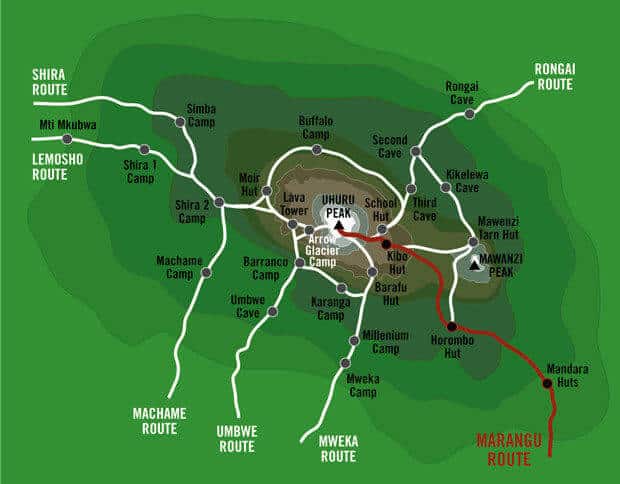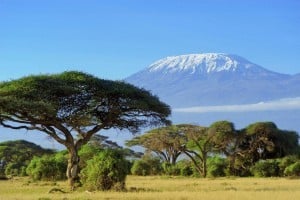Marangu route:
Day one:
From / to Marangu Gate (1980 meters) – Mandara Hut (2700 meters).
Duration: 4 to 5 hours, 7 km.
Setting: Tropical rainforest.
You drive from Moshi to the entrance of the Marangu Gate (1980 meters), all things are done here, entrance fees, subscriptions etc. The walk through the rainforest at the foot of Mt. Kilimanjaro, you see all kinds of exotic birds, and black and white colobus monkeys. Arriving at the Mandara huts you can relax and enjoy the surroundings, but if you want you can also walk to the Maundi crater. You have a fantastic view over the Maasai steppe here, the walk takes approximately one and a half hours.
LB, AM.
Day two:
From / to Mandara Hut (2700m) – Horombo Hut (3720 meters). KiliDuur: 4 to 5 hours, 11 km.
Setting: Tropical rainforest, moorland (lunar).
Here you leave the woods, and now walk through a kind of lunar landscape of sand, rocks and stones, with here and there a cactus, lobelia and proteas and some other vegetation. Also, you will see Mawenzi Peak, and Uhuru Peak (the snow-capped summit of Mt. Kilimanjaro). In Horombo you sleep in huts again, if you have an extra acclimatization scheduled here you stay a day longer.
Day three:
From / to Horombo Hut (3720 meters) – Kibo Hut (4703 meters).
Duration: 5 to 7 hours, 10 km.
Environment: Desert.
The snowy peak of Kilimanjaro is getting closer, halfway this climb is the last water point, but this water is very turbid, so it is advisable to bring enough water purification tablets.
O, LB, AM.
Day four:
From / to Kibo Hut (4703 meters) – Uhuru Peak (5895 m, top) – Horombo Hut (3720 meters).
Duration: From Kibo Hut to Uhuru Peak 7 to 8 hours, 4 km – From Uhuru Peak to Horombo Hut 4 to 5 hours, 14 km.
Environment: Desert, snow / ice fields.
You leave in the middle of the night, so around twelve o’clock, you climb in about six hours to Gilmans Point where you are experiencing the dawn of your life, by this time, all your water is already frozen, and freezes between ten and twenty degrees from Gilmans Point to Uhuru Peak is still a climb from one to two hours, this is by far the hardest part of the climb. The way you can start and run from the top to Horombo hut again, if you’ve arrived here, you sit up there climbing around thirteen to fourteen hours. Time to look at the bed, and enjoy a well-deserved rust.O, LB, AM.
Day five:
From / to Horombo Hut (3720 m) – Marangu Gate (1980 m).
Duration: 5 to 6 hours, 18 km.
Setting: Moorland, tropical rainforest.
Just before the end, you can, if your feet this still allow at least, visit a waterfall, it’s a detour of about twenty minutes, and I recommend, shoes and with bare feet in the icy mountain water, I can out of their own experience tell you that this feels very good. After that, the bus / car back to Moshi, or drive back to Arusha where you are in your hotel you can take a nice hot shower or take a refreshing dip in the pool.
O, LB, AM.
Included:
National Park fees, camping fees, rescue fees.
Full board accommodation during ascent, you spend the night in cabins.
English speaking guide, cook and porters.
Getting to Mount Kilimanjaro, and back to Moshi / Arusha.
Three meals a day
Sleeping bag
Water
Not included:
Meals and accommodation in Arusha
Personal expenses and gratuities.
Toiletries
Tips
Prices:
Five days, four nights
2 persons: 1325€ per person
3+ persons: 1299€ per person
If you Gilmans Point (green certificate) or Uhuru Peak (gold certificate) have passed, then you get to the entrance / exit a certificate with the message that you have reached the highest point in Africa.
Beware!
Mountain
Climbing Mt. Kilimanjaro is often taken lightly, because we no ropes, irons or other attachments need, this does not mean that you will reach the top. Every year approximately 22 000 people start the climb to the summit of Mount Kilimanjaro, only 60% gets the actual summit also (Uhuru Peak). 40% do not make it have different reasons, it may be because their condition is not good enough, or that they deal with altitude sickness get (throbbing headache, vomiting, nausea, and feeling tired and lethargic), in most cases, this time will be noticed by your guide, but unfortunately there are still too many incompetent guides, or not notice this too late. Every year people die by incompetent guides, be sure you book with a professional and competent company. All our main guides have at least 5 years experience with climbing Mt Kilimanjaro, and have the proper training and papers.
I climbed myself Kilimanjaro, and it is a fantastic ascent you the rest of your life with will continue, but beginning well organized the climb, these are a few tips which I definitely would recommend, also improve these tips your chances of reaching the summit considerably:
Train at least two months before your departure two to three times a week, you can go jogging or take long walks.
Train with a backpack of at least four kilograms, you carry on Mt. Kili itself a backpack that weighs about four kilograms (packed lunch, camera, binoculars, water, etc.), if you’ve never trained with this you get great muscle soreness in your shoulders.
Walk in your shoes, so do not go with brand new shoes on the mountain.
Get enough socks dry, this helps prevent blisters.
Take a high factor sunscreen, factor 25 or 30, at 3000-4000 meters altitude you naturally burn faster.
Take muesli bars and glucose along (dextro energy).
Enough warm clothes (flees).
Sufficient water purification tablets.
Norit tablets.
Good sunglasses (with UV filter).
Any tablets that help prevent altitude sickness, such as Diamox.
Headlamp or flashlight.
Rainwear.
Garbage bags.
Reading book and / or music.
Drink plenty of water during each trip.
Walk slowly and enjoy the surroundings. (too quickly climb up increases the risk of altitude sickness).




